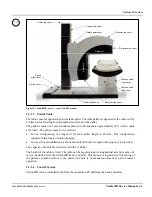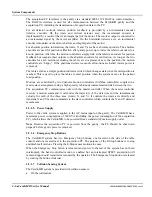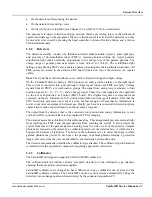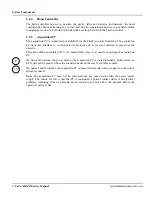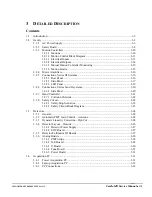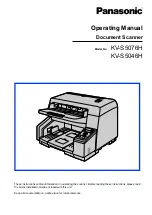
Detailed Description
1MAN0158-H11 04-2005 CSIP Level 1
CardioMD Service Manual
3-11
All motions except table longitudinal are operated by servo motors, capable of running
preprogrammed motions from the acquisition PC. The servo motors are controlled by two two-
axis motion controllers. The motion controllers operate the motors through dedicated amplifiers.
Figure 3.11 on page 3-16 shows the location of motion controllers and amplifiers inside the table
console.
For all detector motions, relative position feedback is provided by an incremental encoder
(relative encoder). On the rotate and vertical detector axis, the incremental encoder is
implemented by a resolver that is an integral part of the motor connecting to the motor amplifier.
The motion controllers read the incremental position from the motor amplifiers.
On the horizontal detector axis, an incremental encoder is mounted on the motor shaft (inside the
motor).
For absolute position information, rotate, X and Y have absolute encoders. The signals from the
absolute encoders are sent to the master motion controller and used for position calibration upon
gantry power-up. The purpose of this is to index the relative encoders to a known position. After
this, the motion controllers only look at the relative encoders for position feedback, but compare
their outputs to the absolute encoders for verification. As long as the two encoders for each motion
(with the exception of the table) agree as to the position, the motion controllers are “happy”.
The table axis has no position encoding or reporting. The table longitudinal motion is operated
manually from the hand controller and works only at fixed speed.
Note
. As part of the automated motions bringing the system into the patient load position, the
table is automatically set to its center position.
All motions can be operated from the hand controller and also from the acquisition PC (table
motion is only operated by the acquisition PC when the system is placed in the patient load
position). The acquisition PC always displays the position of the detector in terms of angle of
rotation, X position and Y position.
For convenience during service and installation, the detector motions can also be operated from
the hand controller when no acquisition PC is connected.
3.2.3.2
Motion Control Block Diagram
Two two-axis motion controllers are used for a CardioMD system. Each axis of a motion
controller is composed of:
•
A control port for:
-
Motor control voltage
-
Amplifier enable output
-
Amplifier fault signal input.
•
An encoder input port for incremental position information input.
The vertical drive and the rotate drive each consists of:
•
A motor with resolver output
•
An amplifier
•
An absolute position encoder
•
Ultimate limit switches
•
A motion control part.
A block diagram is shown in Figure 3.9 below.
Summary of Contents for CARDIOMD
Page 1: ...CARDIOMD SERVICE MANUAL 1MAN0158 H11 04 2005 CSIP Level 1 ...
Page 10: ...Introduction x CardioMD Service Manual 1MAN0158 H11 04 2005 CSIP Level 1 ...
Page 16: ...Safe Operating Practices 1 6 CardioMD Service Manual 1MAN0158 H11 04 2005 CSIP Level 1 ...
Page 164: ...Detector Calibration Files 5 60 CardioMD Service Manual 1MAN0158 H11 04 2005 CSIP Level 1 ...
Page 328: ...Installation Procedures 9 38 CardioMD Service Manual 1MAN0158 H11 04 2005 CSIP Level 1 ...
Page 348: ...Planned Maintenance Procedures 11 6 CardioMD Service Manual 1MAN0158 H11 04 2005 CSIP Level 1 ...
Page 465: ......

